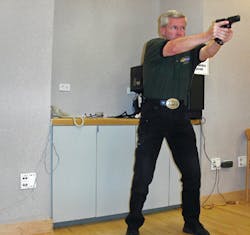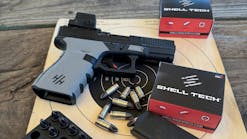The question of which stance is ideal has been debated for many years, and generations of cops have come up with what they feel is the best stance to assume when shooting and/or fighting. Isoceles? Weaver? Right from the beginning, I’d like to make a one distinction regarding shooting in general. Shooting is not the same as gun fighting; the two have similarities to be sure, particularly regarding the mechanics of operating the weapon. However, shooting includes practice on the range with paper, static targets, firing for a qualification score, and for some, competition such as bulls eye targets. Gun fighting involves one major difference—it results in either saving your life or the life of another.
In my more than three decades in law enforcement, I’ve fired thousands of rounds and trained scores of others on the mechanics of shooting. In my view, our training has “devolved” to the point where the most important component of any firearms training day is ensuring everyone fires a qualifying score. Tension and anxiety peak just before the qual course is fired. Once that monkey is off everybody’s back, and everyone has qualified, one can almost feel the stress leaving the range.
As the instructor in charge, I used to transition from the administrative firing to the more pragmatic training: combat courses. At about this point I often observed a light-hearted attitude begin to emerge among the officers, almost as if I was now there to entertain, rather than train them. The fact is, combat courses that include running and other movement, combined with targets that are three dimensional and moving as well, are the most important firearms training cops can engage in.
So how does all of this relate to stance? I contend that combat courses, not qualification courses, are the meat and potatoes of a police officer’s training. Teaching a cop how to move and shoot is what saves lives. The stance is a basic component of marksmanship, and it’s my contention that Isosceles is the all-purpose stance for both gun fighting and just plain fighting in general.
If you take a look at most gun battles, the videos seem to be bountiful now with the proliferation of camera phones and dash cams, you can clearly see that most officers, and even the bad guys, are shooting from an isosceles stance. Why? Because it’s a natural position for the body to assume. Go to any defensive tactics or martial arts instruction, and the stance they teach is isosceles. Feet shoulder width apart, knees slightly bent, one foot slightly ahead of the other—this position affords stability, front and rear. Most important for gun battles, this fighting stance allows for a 180-degree arc of peripheral vision.
Contrast Isosceles with the Weaver stance, one that has been around for a long while and is still used by some shooters, albeit in a modified form, and you will find several disadvantages. The most apparent disadvantage is the lack full peripheral vision needed to cover your flank. Depending on how “Weavered” you are, you may have your back to an adversary while using this stance. If you are in uniform and vested up, the shooting arm may become encumbered by the vest because of the awkward position of being on a 45-degree angle.
To reinforce the concept that Isosceles is a natural body position, I’ve taken note of shooters who fire qual courses from the Weaver. Once they’ve fired their passing score, and combat or skill builder courses were set to begin, they revert to an isosceles stance—nice wide base, knees bent and even weight distribution. It’s comfortable. Incorporate extending the arms fully, with the shoulders rolled forward, and you create the perfect platform for absorbing recoil for successive shots. From this position, the shooter can easily move in any direction, drop to a knee or go prone.
Most gun fights happen in the blink of an eye, and end just as quickly. There’s no time to think about proper stance or anything else, only enough time to do what comes naturally. Shootings occur at arm’s length, not 15-25 yards. Thus, the importance of training with combat courses and imprinting the winning mindset in each officer’s psyche.
The same advantages of the Isosceles accrue to non-shooting situations. The Isosceles position is a great fighting stance. It allows one to be balanced and ready to move or react to an adversary’s attack. Hands should be in front, waist level or slightly above, strong side just slightly to the rear, and body position slightly off-center from our opponent. Just as in shooting incidents, fights often occur without warning. The Isosceles affords readiness for either.
By the way, the Isosceles stance works with one-handed gun fighting as well. For instance, when the non-dominant hand is operating a flashlight, or you are pushing away from an opponent—the same rules apply. One word of caution, don’t shortchange the other basic marksmanship tenants, such as grip and sights. Always use a hard grip, hold that pistol as hard as you can and keep that front sight in view. Press the trigger, don’t jerk it. Do the same things the same way all of the time. Convince yourself that you are a winner and you will be. Remember, gun fighting is the culmination of shooting, training and mindset, which, incidentally, is also Isosceles in nature.
Stay safe, Brothers and Sisters!
Web Links:
- LivSafe--Stay Aware, Stay Safe!
- Chicago Warriors Midnight Battles in the Windy City by John Wills
- Gripped By Fear by John Wills
About The Author:
John M. Wills spent 33 years in law enforcement as a Chicago Police Officer and FBI Special Agent (Ret). He is a Freelance Writer and Speaker whose third book, TARGETED, is now available online at Amazon and Barnes & Noble. Contact John through his website: www.johnmwills.com.

John Wills
John M. Wills is a former Chicago police officer and retired FBI agent. He is a freelance writer and award-winning author in a variety of genres, including novels, short stories and poetry. John also writes book reviews for the New York Journal of Books, and is a member of the National Book Critics Circle. His new book, The Year Without Christmas, is available now. Visit John at: www.johnmwills.com.



